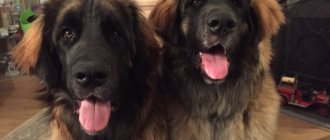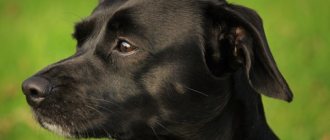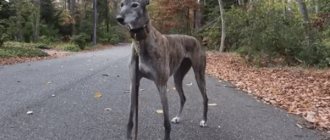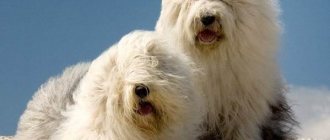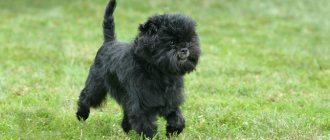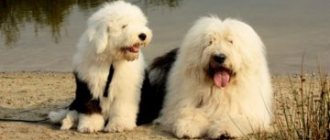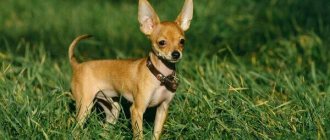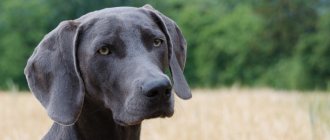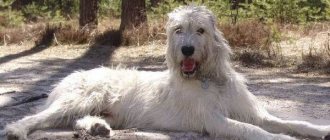Leonberger is a tall, hardy dog with a large head and a muscular body covered with thick red hair. Once used as a shepherd, watchman and light load carrier, it today enjoys a reputation as an intelligent and noble companion. Let's find out what a Leonberger is and what features are hidden behind its menacing appearance.
Breed traits
Breed traits (on a 5-point scale)
| Leonberger | |||
| Activity | in the house | 3 | |
| on the street | 3.3 | ||
| Obedience | training | 4.3 | |
| strangers | 4 | ||
| Domination | in family | 2 | |
| over dogs | 3.3 | ||
| Defending your territory | from people | 3.3 | |
| from dogs | 4 | ||
| Sociability | in family | 4.7 | |
| with strangers | 4.7 | ||
| with dogs | 3.3 | ||
| Concentration | in family | 1.7 | |
| in front of strangers | 2.3 | ||
| with dogs | 2.3 | ||
| Aggressiveness | in family | 1 | |
| to strangers | 1 | ||
| to the dogs | 2.7 | ||
| to cats | 1.7 | ||
| Family behavior | calmness | 4.3 | |
| demand for affection | 4.3 | ||
| excitability | 2.3 | ||
| playfulness | 4.3 | ||
| excessive barking | 1.7 | ||
| behavioral breakdowns | 2 | ||
| Tolerance for children | up to 4 years | 4.7 | |
| over 4 years old | 4.7 | ||
| Institutional use | watchman | 4.7 | |
| bodyguard | 2.7 | ||
This breed is often compared to the following dog breeds: Caucasian Shepherd, Newfoundland, St. Bernard, German Shepherd, Great Pyrenees (Pyrenees Mountain Dog).
The photo shows what these dogs look like:
Pros and cons of the breed
The Leonberger's menacing appearance does not match its phlegmatic temperament. To understand whether it is suitable for specific tasks, it is better to study the basic characteristics of the breed in advance.
| pros | Minuses |
| Balanced psyche | Unsuitability for apartment living |
| Absence of unmotivated aggression | Intensive shedding |
| Friendly attitude towards children |
The Leonberger is a huge shaggy dog with an impressive appearance and a noble soul. A sensible and slightly phlegmatic giant, he easily copes with the functions of a watchman, nanny and companion and is ideal for a large and friendly family living in their own home.
General characteristics of the Leonberger breed
Leonbergers are a working dog breed. They were bred specifically to help people and to do various jobs. At first they were used as draft power. They helped herd and guard livestock, guarded the house and plot. This is an excellent family dog - despite its huge size, it is good-natured and can be a nanny. She also makes an excellent guide and rescue dog.
The name of the breed is associated with the city of Leonberg, where it was bred. But it can be associated with the appearance and character of these dogs. Leonbergers is translated from German as “mountain lion”. Representatives of the breed are large, powerful, with thick shaggy hair of one of the shades of red and a regal posture. By nature they are calm, courageous, self-confident and unflappable.
| Options | Characteristic |
| breed name | Leonberger (German: Leonberger) |
| a country | Germany |
| time | 19th century |
| breed group | pinschers and schnauzers, mountain and Swiss cattle dogs |
| application | companion, watchman, security guard, shepherd, rescuer |
| life expectancy | 9-11 years |
| height | males 72-80 cm, females 65-75 cm |
| weight | males 59-77 kg, females 45-59 kg |
| aggression | No |
| activity | average |
| intelligence | standard |
| training | easy to handle, suitable for inexperienced owners |
| care | easy, but sheds a lot |
| health | good |
pros
The main advantage of the Leonberger is its balanced temperament and good-natured character. This is a calm, imperturbable dog, it is difficult to anger him. He is smart, easy to train and not prone to dominance, so he is suitable even for inexperienced owners. These dogs do not need to be specially trained to guard a home or rescue people. They have innate protective qualities and a pronounced territorial instinct. And if they see that someone needs help in the water, they will rush to save without the owner’s command. The Leoneberger has several more advantages:
- he has no aggression;
- devoted, affectionate, good-natured;
- sociable, easily finds a common language with any person;
- obedient, reasonable, tries to please the owner;
- has an attractive appearance;
- in adulthood she can be an excellent nanny;
- unpretentious, not picky about food;
- he does not tend to drool heavily;
- strong, resilient and efficient;
- lives quietly next to other pets;
- vigilant watchman;
- does not bark without a reason;
- has good health.
Minuses
Leonbergers are large, powerful dogs. They require a lot of space, so they are not suitable for a small apartment. The breed is quite rare and expensive. And keeping such a large dog can be expensive. Leonbergers have a few more disadvantages:
- love to swim - even in puddles or mud;
- mature slowly, becoming fully mature by 2 years;
- the coat sheds heavily;
- have a low life expectancy;
- slow and phlegmatic;
- do not tolerate heat well.
The video complements the characteristics of the breed:
Video: Leonberger dog description of the pros and cons of the breed
Video: This breed is Leonberger
Video: Leonberger. Pros and cons, price, how to choose, facts, care, history
How to choose a pet
Leonberger is a rare and expensive breed. The cost of such a dog varies between 40-100 thousand rubles and depends on the reputation of the nursery and the presence of champions in the pedigree.
In order not to make a mistake in choosing a puppy, you need to pay attention to:
- presence of metrics and stamps;
- compliance with the breed standard;
- behavioral characteristics of parents and puppies;
- living conditions for mother and offspring.
A healthy Leonberger puppy should have thick, even paws, clear eyes, a strong, moderately well-fed body, clean ears and fluffy fur without bald spots.
History of the origin of the breed
The Leonberger breed appeared in Germany in the 19th century. The mayor of Leonberg, Heinrich Essig, decided to breed large dogs. He decided to breed a new breed, the representatives of which would resemble a lion - the symbol of this city. He began his selection by crossing Newfoundlands and St. Bernards. A few years later, Pyrenean mountain dogs began to be used for breeding. Essig wanted to get a color similar to a lion's, and he succeeded.
In the middle of the 19th century, the new breed was recognized by German dog breeders and registered under the name Leonberger. These dogs turned out to be large, with long thick hair and a characteristic black mask on the muzzle. At first they gained popularity among farmers, as they were hardy and efficient, swam well, had excellent hearing and a fearless character. They became a symbol of the city of Leonberg, they even erected a monument there.
But Essig began to advertise his dogs in aristocratic circles. Over the course of 10 years, they gained popularity among the nobility; owning such a dog became prestigious. Puppies were expensive. At the end of the 19th century, German breeders developed a breed standard. But it received international recognition in 1905.
By the middle of the 20th century, the breed was on the verge of extinction. After World War II, only 8 Leonbergers remained in Germany. Now the population of the breed has been restored, but it is still one of the rarest in the world. Leonbergers came to Russia at the end of the 20th century. Until now, the breed has not become popular and is small in number.
Interesting Facts
The Leonberger is a dog with a rich history, which contains many surprising facts:
- The breed is named after the German city of Leonberg, whose mayor was Heinrich Essig.
- Initially, Leonbergers were used as available draft power. The dogs were harnessed to light wooden carts and transported small loads.
- Leonbergers were popular among representatives of aristocratic circles. Famous owners of dogs of this breed include Napoleon III, the Prince of Wales, Richard Wagner and the Austro-Hungarian Empress Sissi.
- In Vienna there is a monument to the Austro-Hungarian Queen Elisabeth of Baden, where she is immortalized surrounded by her Leonbergers.
Description of the appearance of Leonbergers
The Leonberger is a large, broad-chested dog with a harmonious build and thick coat. The height of males can reach 80-85 cm, weight – 70 kg. The peculiarity of the breed is that the females are very different from the males. They have a weakly defined withers and collar. Leonberger females are also smaller in size: their weight is no more than 59 kg, and their height rarely reaches 75 cm.
Head
The head is massive, but proportional to the body. The skull is convex and moderately pronounced. The muzzle is wide, elongated, but not narrowed. There is a small hump on the back of the nose. The lobe is large and must be black. The jaws are strong with a scissor bite. The lips are black, thin, and do not form jowls.
The eyes are oval, medium in size, set quite wide at stop level. The eyelids are black, close-fitting, the whites are almost invisible. The color of the iris can be light or dark brown. The ears are hanging, small, but fleshy. They have a triangular shape with rounded ends. Set on high, close to the cheeks.
Frame
The neck is long, muscular, without dewlap. The scruff is well defined, especially in males. The body is harmoniously built, almost rectangular in format. According to the standard, the length should be slightly greater than the height at the withers: proportions 10:9. The back is wide, straight, the croup is rounded. The chest is voluminous, deep, reaching to the elbows. The stomach is slightly tucked. The tail is set low and heavily covered with hair. Lowered when at rest. When excited, the tip may rise, but not higher than the back.
Limbs
The limbs are strong and strong. The front ones are set parallel, quite wide. The shoulder blades are inclined, the elbows are pressed to the sides. The hindquarters are muscular, the thighs are long, the angles of the joints are well defined. The paws are compact, the toes are gathered into a ball. There are jumpers between them, thanks to which the dog swims well. The pads are thick and prevent slipping when running. Movements are uniform, sweeping, free.
Coat and colors
The coat is double and thick. The guard hair is of medium length, moderately soft, straight. The undercoat is fluffy and dense. The fur is longer on the neck and chest - forming a lion's mane. There are pronounced featherings on the legs and tail.
The breed standard provides for several Leonberger colors. It can be any shade of red: yellow, sand, reddish brown. Fawn color is allowed - with black tips of the hair. There may be a small white spot on the chest. A mandatory sign of the breed is a black mask on the face, the tips of the ears are also dark.
Photos complement the description of the breed:
Character traits
Leonbergers are people-oriented dogs. They are sociable and easily find a common language with everyone. Peaceful, accommodating, do not show aggression or suspicion, and are not prone to dominance. Because of these qualities, as well as their quick wit and high intelligence, they make excellent guide dogs.
This dog becomes very attached to its owner and family members and needs constant attention. Although you can’t tell by his behavior - he likes to lie quietly, passively observing those around him. But he is always ready to support the game or just be close to the owner. Leonbergers react painfully to prolonged separation from their family and have a hard time with a change of owner. Lack of attention and loneliness can lead to depression and other disorders.
These dogs are good-natured and flexible. They never compete with their owner for leadership. They do not like conflicts, quarrels, or raised voices. Leonbergs do not see strangers as enemies. Although it is a good guard dog, it is not suspicious or mistrustful. Although, if necessary, she will always protect the owner and his property. This dog scares off intruders with just its appearance and deep barking.
Leonbergers love children very much. They are patient with them, affectionate, ready to protect and support any games. An adult dog is capable of becoming a good nanny; he will never offend the baby, and will take care of and protect him. This attitude is not only towards family members, but also towards other people's children. Although puppies perceive children as their relatives. And Leonbergers mature late. Children under 2 years of age should not be left alone with a pet, as it may accidentally drop the baby, crush or bite.
Leonbergs get along well with any pet. They never chase cats or birds and react calmly to small noisy dogs. They do not enter into conflicts with other dogs, although if necessary they easily fight back. Another feature of representatives of this breed is that they are calm about loud sounds.
These dogs are characterized by the following character traits:
- livability;
- prudence;
- good nature;
- equilibrium;
- patience;
- devotion;
- slowness;
- fearlessness;
- cheerfulness;
- sociability.
Education and training
Leonbergers are very smart, quick-witted and flexible. They are not prone to dominance, so they are easy to train. But it is necessary to begin education and socialization from an early age. By the time the puppy begins to be taken for walks, he should calmly respond to the sounds of the street and strangers, be able to walk on a leash, and understand basic commands.
The dog must immediately learn the rules of behavior. She needs to be accustomed to her name, place, and food intake. It is especially important to immediately teach the puppy to walk next to you and not pull on the leash. You also need to know the following commands:
- to me;
- sit;
- stand;
- it is forbidden;
- ugh;
- lie.
Puppies need to be exercised regularly. It is better to build training in the form of a game; they should be short and interesting. These dogs are smart and quickly understand what is required of them. They try to please their owner, although they do not like monotony and do not learn tricks well. Leonbergers will not unquestioningly follow the same commands like shepherds. It should be taken into account that representatives of the breed are slow, so it is important to be patient.
When dealing with a Leonberger, you need to be moderately strict. Raising your voice or using physical punishment is not recommended. These dogs react painfully to violence. A good punishment for a pet would be to stop playing and get a stern voice from the owner. But it is better to use affection, praise and treats more often in education. Many owners note that these pets react to the tone of voice, intonation, and understand a person perfectly.
Interesting photographs illustrate the character and behavior of these dogs:
Maintenance and care
Leonbergers are unpretentious, they live quietly in the house without creating any problems. But it is better to keep this dog on the site. Thanks to its thick coat, it tolerates the cold well. You can’t put her on a chain – representatives of the breed need freedom and constant contact with people. It is also not recommended to close the dog for a long time in the enclosure. He should be able to freely enter the house.
For any type of keeping, it is necessary to take your dog for a walk twice a day. Although Leonbergers do not need much physical activity. Walks do not have to be long; you should not force your pet to run a lot. Serious exercise is especially contraindicated for puppies. It is not recommended to allow them to jump or walk on stairs. But they must gain new impressions and explore the world around them.
Hygiene procedures
The Leonberger's coat is thick and long, and quickly becomes tangled. It sheds heavily 2 times a year, and if the dog lives in the house, it gradually sheds a little constantly. The coat must be brushed daily. Use different combs, brushes, tangle cutters, and slicker brushes for this.
You need to bathe your Leonberger when it gets dirty. When keeping in the house, you can do it every month so that the smell of the dog does not appear. In summer, it is worth giving your dog the opportunity to swim in open water - they love to swim. But you need to take into account that they don’t mind swimming even in a puddle, so they often get dirty.
Several more mandatory procedures will be required, which the pet must be accustomed to from an early age:
- examine your eyes every day and, if necessary, remove discharge with a cotton pad soaked in tea or boiled water;
- Once a week, clean the ears from wax and dirt, you can use Chlorhexidine or a special veterinary lotion;
- if the claws do not wear down during walks, they need to be trimmed once a month; this must be done on dewclaws;
- It is important to take care of your pet’s teeth; you can prevent the appearance of plaque and tartar by weekly brushing with special pastes.
Nutrition
You can feed your Leonberger both dry food and natural products. These dogs have a slow metabolism, so they eat little. It is contraindicated to overfeed them. They are prone to gaining excess weight and bloating. Therefore, you need to feed in small portions several times a day. Puppy - from 3 to 6 times depending on age, after a year - 2 times.
Food should not be very high in calories, but must be rich in beneficial microelements and all essential nutrients. You should not give your dog food from your table, fatty foods, or sausages. Sweets, baked goods, smoked foods, and pickles are contraindicated.
The diet should consist of lean meat or offal, vegetables, cereals (no more than 20%). It is useful to give fermented milk products and vegetable oil. It is necessary to add vitamin and mineral complexes to food, calcium is especially important. Adult dogs are given chondroitin and glucosamine supplements as recommended by a veterinarian to help prevent joint problems.
When feeding dry food, you should give preference to premium and super-premium brands. They should be designed for large breeds, but for low-active dogs.
Health
Leonbergers have a short lifespan. Like most large dogs, they live on average up to 10 years. Some individuals live 11-12 years, but no more, and this happens rarely. Although these are quite healthy and strong dogs. When properly maintained, they rarely get sick. But sometimes the following diseases occur:
- hip dysplasia;
- arthritis;
- osteosarcoma;
- osteomyelitis;
- turning of the eyelids;
- Addison's disease;
- indigestion;
- allergy;
- dermatitis.
Possible diseases
The most common diseases that Leonbergers suffer from are:
- Hip dysplasia. It appears mainly in puppies. With it, the dog appears lame when moving, and does not want to actively move. Treatment in this case consists of taking medications; if they do not help, then surgery is prescribed. Modern breeders, having discovered this disease in a puppy, do not allow him to have offspring.
- Turn of the century. Usually appears on the lower eyelid. This disease is inherited or in rare cases can appear after conjunctivitis. Just like with dysplasia, dogs with this disease are not bred.
- Addison's disease. Manifested by a hormonal disorder of the adrenal gland. The disease is accompanied by diarrhea, weakness, and vomiting. Treatment is only relevant in the early stages. If time is lost, the dog often dies.
- Osteomeilitis. It is a temporary disease that affects the bones of puppies. In this case, the pet begins to suffer from lameness, for no reason. No treatment is prescribed for this disease; it goes away on its own. The only thing that veterinarians recommend is more thorough care during illness.
- Bone cancer. This disease mainly affects dogs aged 7 years and older. There is no treatment, as the cancer metastasizes almost throughout the body. In the early stages, it is often confused with arthritis, as it initially manifests itself as lameness.
How to buy a Leonberger puppy
This breed is rare; according to statistics, there are no more than 10 thousand individuals worldwide. It is not widespread in Russia, but you can find nurseries in Moscow and other large cities. The price for a purebred puppy starts at 40,000 rubles. You can buy a dog without documents cheaper, but there is a risk that it will not be purebred or have hereditary diseases.
Puppies are sold from 1.5-2 months. At this age, the baby should be active and playful. He is already lapping well from the bowl and making contact. Healthy puppies have dark eyelids, lips and nose, no discharge from the eyes, no signs of worms or fleas. They are well-fed, with thick fluffy hair, weighing about 5 kg.
The photo shows what Leonberger puppies look like:
Another interesting video about Leonbergers:
Video: Leonberger.
Video: Leonberger Micah 3 years old 88kg. Leonberger micah 3 years 88kg
Video: Dogtraining 302. Leonberger: barking at the fence, attacks on relatives.
Leonbergers are outwardly formidable, but good-natured dogs. They are bred as a watchdog or companion. They are good with children, loyal and affectionate. If you give this dog enough attention and take care of him, he will become your best friend and loyal protector.
How much does Leonberger cost and where to buy it?
The price of a Leonberger is quite high and does not fall below 30-40 thousand rubles, and the initial cost of a puppy with a good pedigree and a great future is 50 thousand rubles. You can buy a Leonberger in a specialized nursery that breeds this breed.
Under no circumstances should you purchase a puppy from unknown private breeders, since it is not uncommon for dogs with serious deviations from the standard to be sold under the guise of purebred dogs. When choosing a puppy in a kennel, you need to see the Leonberger’s parents in a photo or in person to assess its future.
It is also necessary to check certificates and inspection certificates. After this, get to know your future pets. His reaction should be expressed in interest in communication; if this is not the case, then it is better to refuse to buy this puppy, since problems with his upbringing may arise in the future.
